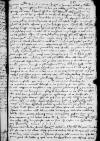Ex amicissimis ⌊⌋ libenter gratissimoque animo accepi diligentiam, quam Dominatio Vestra apud ⌊reginalem maiestatem⌋ pro ⌊Fabiano nostro⌋ impendit, quae non haberet, quod culpam in me reiiciat. Scripseram enim ⌊maiestati eius⌋, cum ⌊palatinidem Pomeraniae⌋ mihi commendabat et a me pro illo resignationem ⌊⌋, ut potius ⌊Fabiano servitori suo⌋ faveret. Ad quod mihi rescribi iussit se nescivisse Fabianum ad spiritualia aspirare, quod si prius habuisset cognitum, iampridem illum ecclesiasticis beneficiis ornasset. Utcumque res haberet, modo ⌊reverendissimus dominus Cracoviensis⌋ resignatione mea, quam ad eius postulationem misi, ut
videtur mihi in novissimis suis promississe[1], non utatur, salva res erit ⌊Fabiani⌋: adhuc mihi apud ⌊Sedem Apostolicam⌋, quousque confirmationem assequar, quantum ad hunc canonicatum meum, omnia sunt integra. Commisi igitur ⌊fratri huic meo Bernardo⌋, quem Dominationi Vestrae commendo plurimum, ut mentem ⌊reverendissimi domini Cracoviensis⌋ expiscetur. Quod si ⌊dominatio eius reverendissima⌋, cui nihil negare potui, missa resignatione usa non fuerit, missurus est ⌊frater meus⌋ aliam in personam ⌊Fabiani⌋ procuratoribus meis[2] ad ⌊urbem⌋. Si quid ea in re opis et consilii in favorem ⌊Fabiani⌋ Dominatio Vestra impendere poterit, cf. Cic. Fam. 13.55.2 nihil est quod mihi gratius facere possis ⌊nihil est, quod mihi gratius facere possitcf. Cic. Fam. 13.55.2 nihil est quod mihi gratius facere possis ⌋
etc.
Ex centum aureis Hungaricalibus, quos mihi ⌊dominus Bohus⌋ pro festo Penthecostes[3] debet, nihil cedit Dominationi Vestrae, cum ecclesiam illam meam[4] libere Dominationi Vestrae et non gravate resignaverim, verum pro veteri meo amore et benevolentia, qua Dominationem Vestram prosecutus sum semper et quam vicissim a Dominatione Vestra sedulo sum expertus, multa debeo. Utque in eo vel ex parte solvendo sim, eos centum aureos Dominationi
Vestrae oppido quam libentissime do atque dono, ut ⌊⌋ ea in re iis iunctis clarius cognoscet. Et si quid magis est, quod praestare possum,
cf. Sen. Ben. 5.23.2 Unde scis, nolim an ignorem, animus an facultas desit mihi? ⌊voluntas adest, modo adsit facultascf. Sen. Ben. 5.23.2 Unde scis, nolim an ignorem, animus an facultas desit mihi? ⌋. Scripserat et in eo mihi ⌊dominus Nibschicz⌋, facillimeque obtinuit, quod sic in animo prius fuit
destinatum et constitutum. Agat tamen cum eo Dominatio Vestra, ut sciat
commendationem suam apud me et pondus et momentum habuisse, et hoc,
quantumcumque sit, boni consulat.
Quod Dominatio Vestra accessioni et translationi meae congratulatur, facit id quidem pro sua virtute et summa erga me humanitate, cumque de benevolentiae in me affectu adeo certus sum, quod nihil mihi possit esse exploratius, ab ea summopere peto, ut si quid ex ⌊castro Marienburgensi⌋, ubi quidem sunt, qui mihi, numquam a me laesi, volunt pessime[5], ad aulam regiam aduolaverit, quod me existimationemque meam niteretur calumniari, quemadmodum pauloante ex eodem loco contra me productae erant machinae, Dominatio Vestra quantum potest me tueri, vel saltem istiusmodi molimina, quae obfecerit, in notitiam meam deducere velit, ut temporius malevolis maledicisque hominibus obiicem ponere, technasque eorum irritas facere possim. Sunt, qui ferre nequeant, cf. Mart. 7.12.8 Qui Phoebi radios ferre diemque negat? ⌊quod sol habeat radioscf. Mart. 7.12.8 Qui Phoebi radios ferre diemque negat? ⌋ etc.
Quod reliquum est, Dominacionem Vestram quam diutissime bene valere, illique omnia fausta opto ac precor.
[1 ] Dantiscus is exaggerating slightly when he claims that Chojeński has given him hope as to Fabian – the Cracow bishop only promised to fulfill Dantiscus’ request as to the queen, meaning he would shield him from her anger (cf. ⌊⌋)
[2 ] At this time, Dantiscus’ plenipotentiary in Rome was Warmia canon ⌊Dietrich von Rheden⌋
[3 ] 1538-06-09
[4 ] In connection with Dantiscus being postulated as Warmia bishop, King Sigismund I asked him to resign from the parish of Gołąb (Cracow diocese), of which Dantiscus was the parish priest, for the benefit of Samuel Maciejowski (cf. ⌊⌋). Jerzy Starnawski – on the basis of rather questionable sources – believes Dantiscus received the Gołąb parish in 1506 at the latest and not, as his biographers claim, in 1521 (cf. cf. STARNAWSKI 1977 p. 194 ⌊Starnawski, p. 194cf. STARNAWSKI 1977 p. 194 ⌋); Maciejowski received the presentation of the Gołąb parish on July 10, 1537 (cf. cf. DWORZACZEK 1985 p. 81 ⌊Dworzaczek, p. 81cf. DWORZACZEK 1985 p. 81 ⌋); cf. also letters ⌊⌋ and ⌊⌋ and ⌊⌋. NB Z. Nowak claims that Dantiscus benefited from the Gołąb income until 1541, and that his brother Jerzy was curate there permanently (cf. cf. NOWAK 1982 p. 159 ⌊Nowak, p.159cf. NOWAK 1982 p. 159 ⌋)
[5 ] Perhaps Dantiscus is referring to the recent disagreements with Malbork treasurer Stanisław Kostka, as a result of which Kostka accused the Prussian Council before the king of conspiracy. The conflict was assuaged at the autumn Prussian assembly of 1536 and, contrary to the fears Dantiscus expresses here, was not renewed.(cf.cf. BODNIAK p. 283-284 ⌊Bodniak, p.283-284cf. BODNIAK p. 283-284 ⌋)
